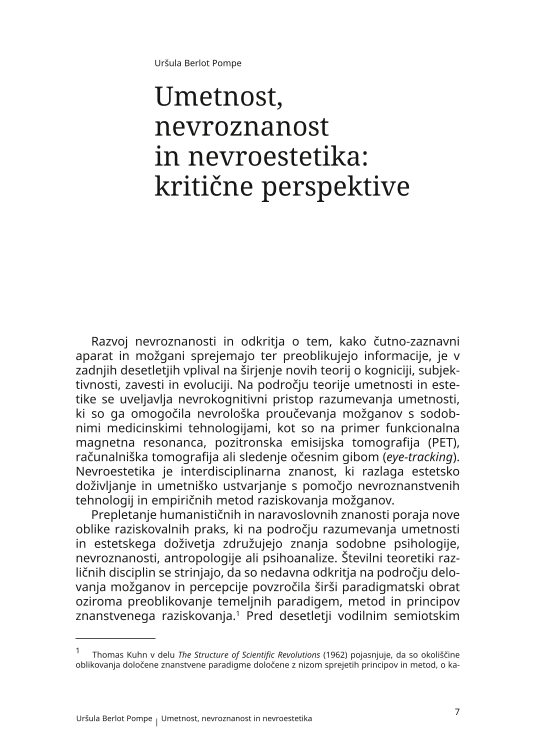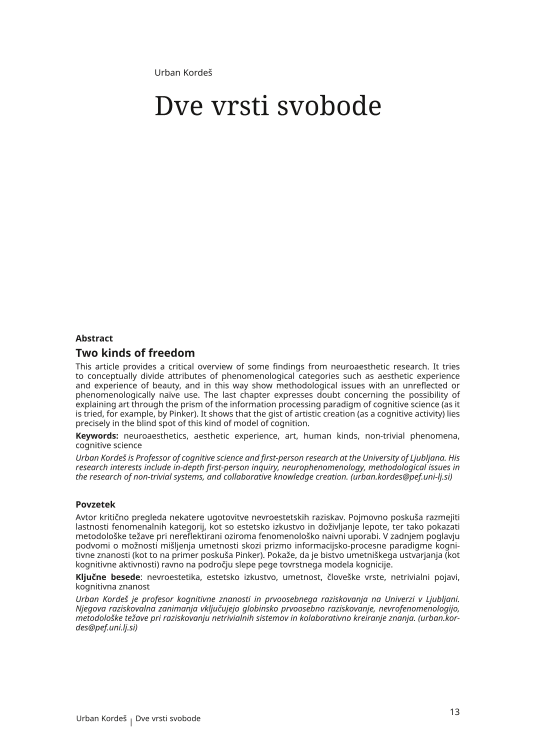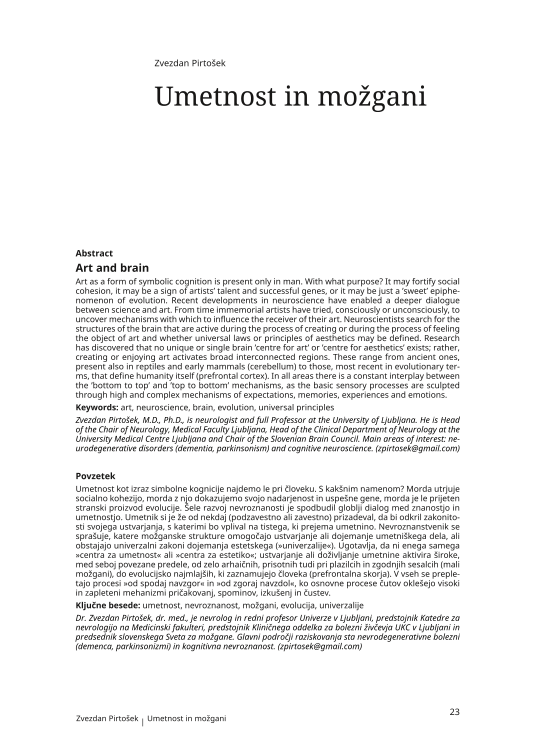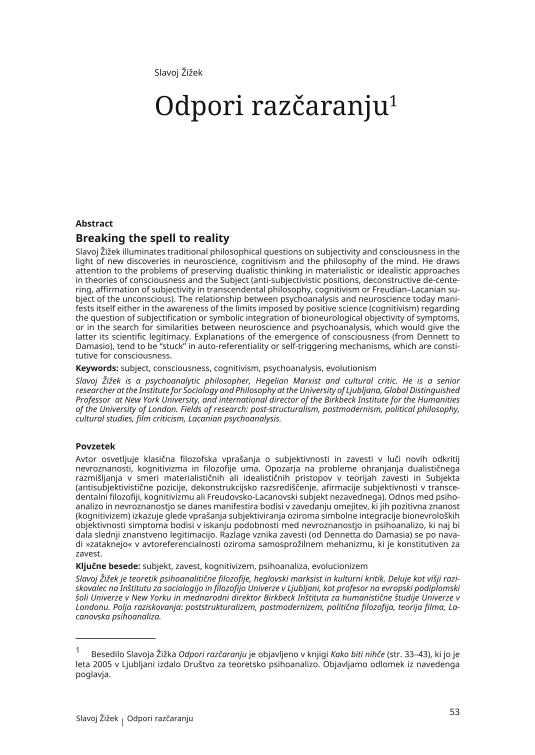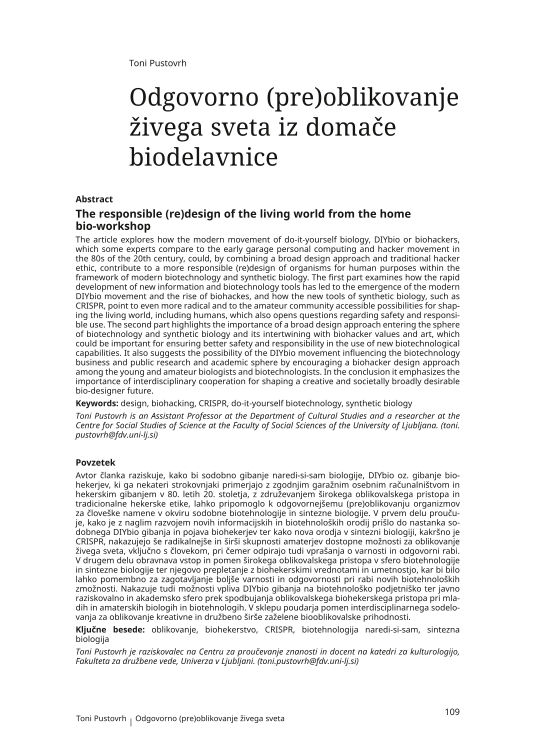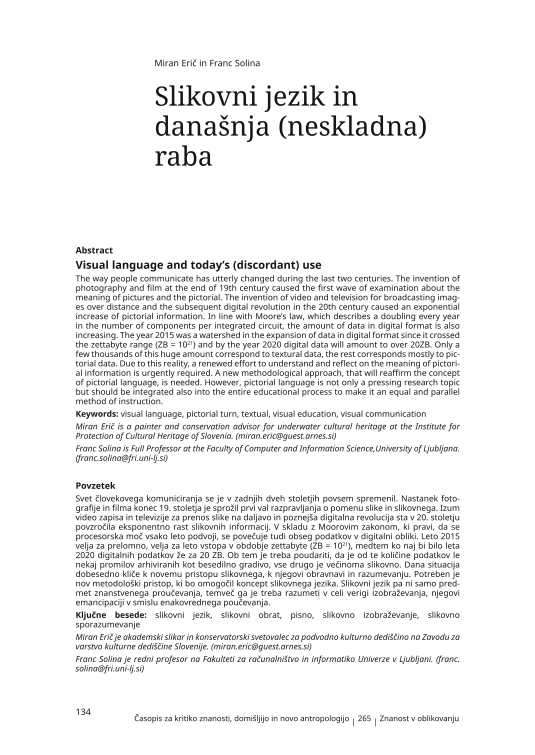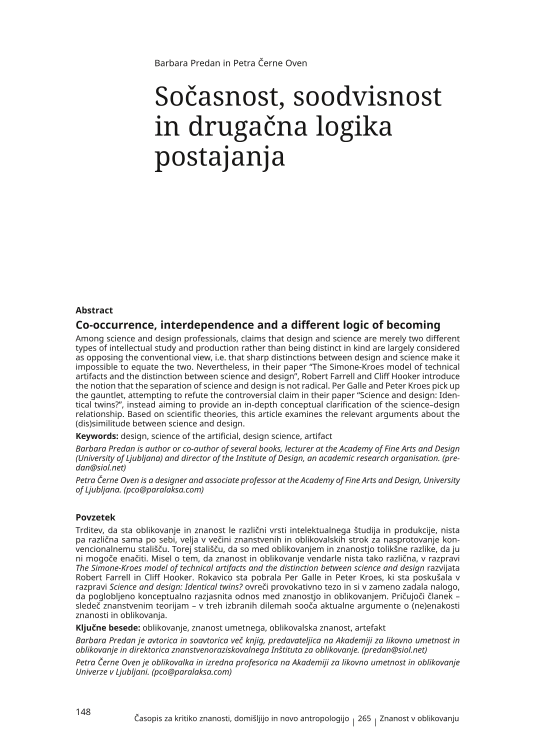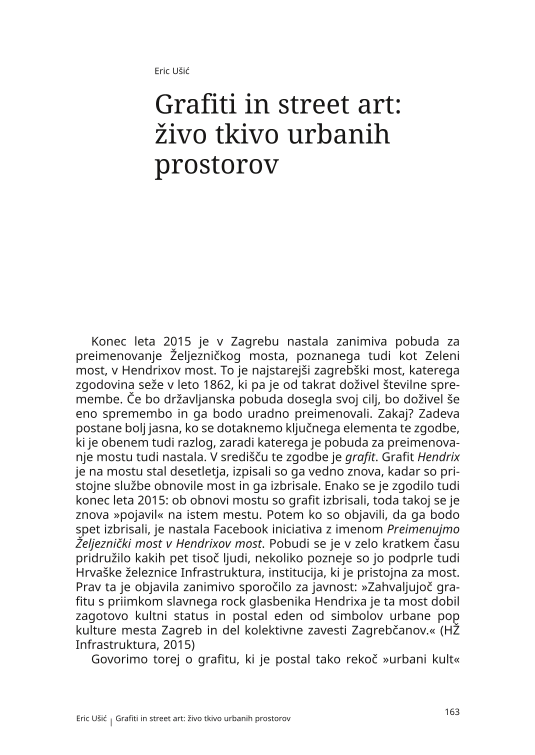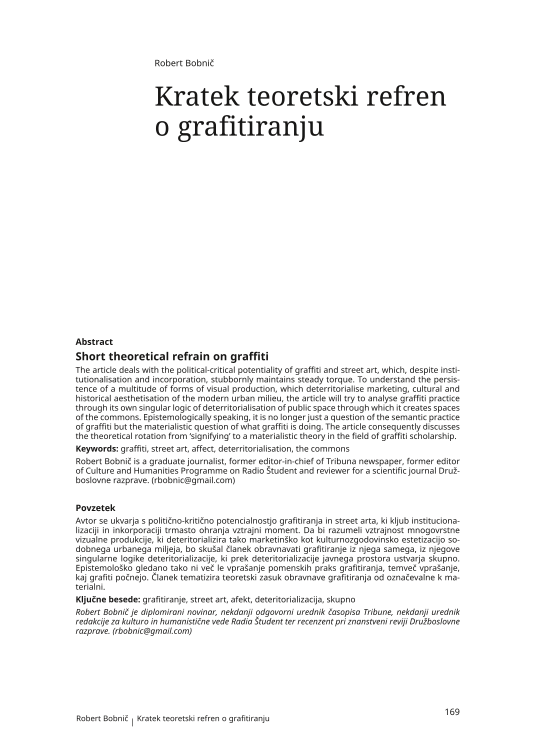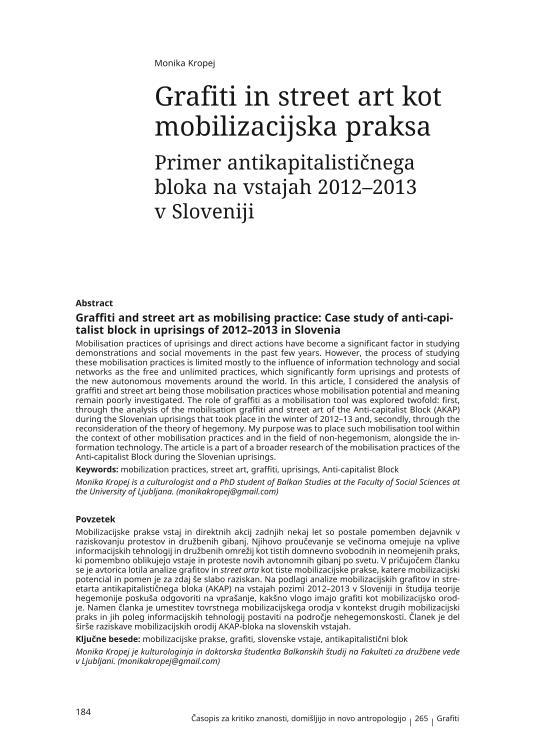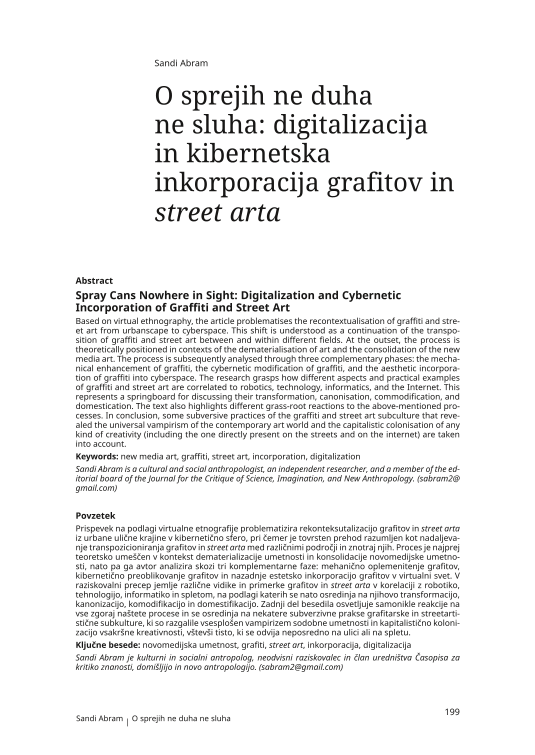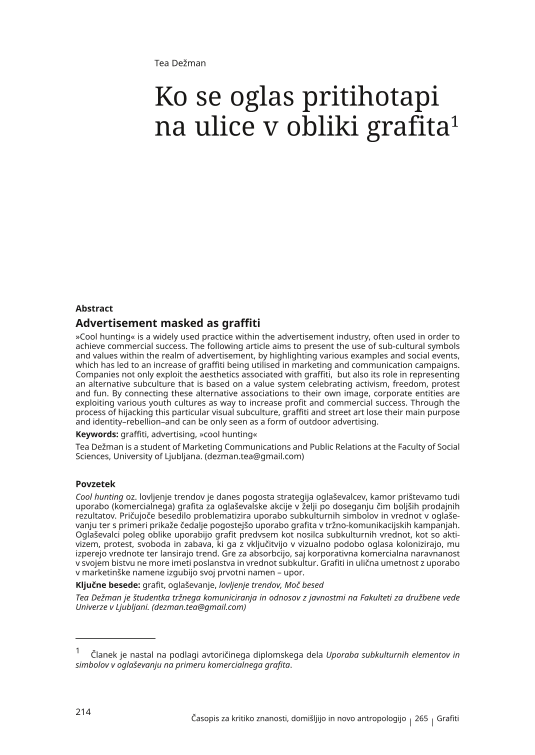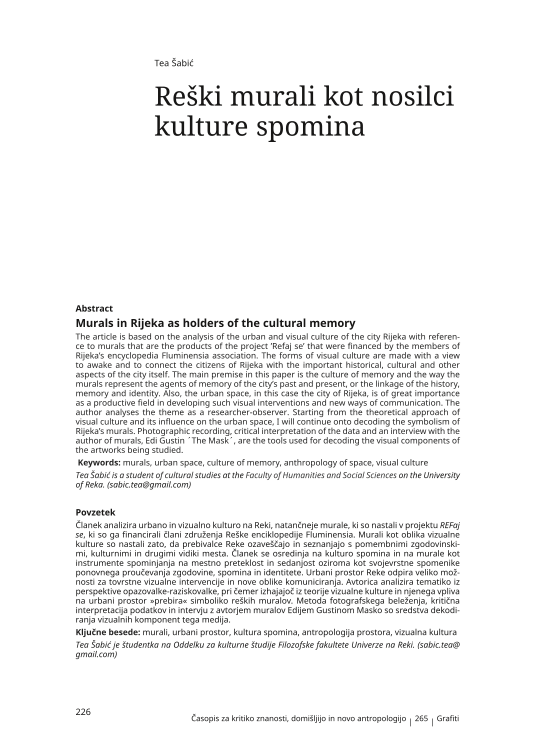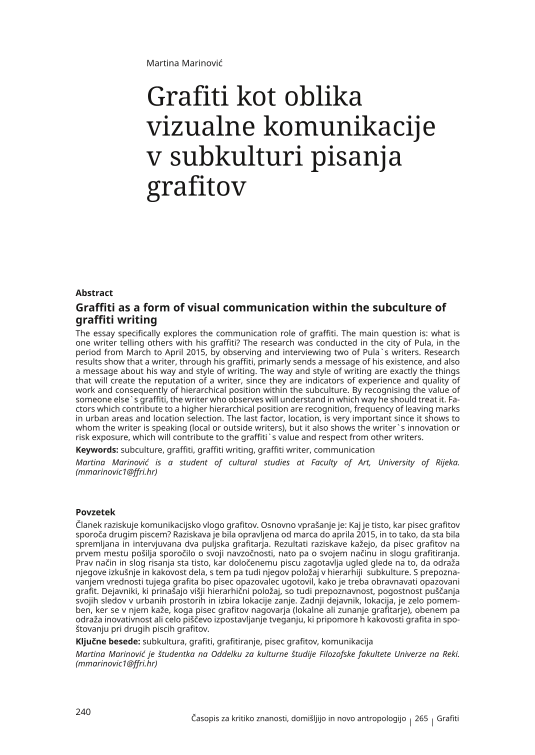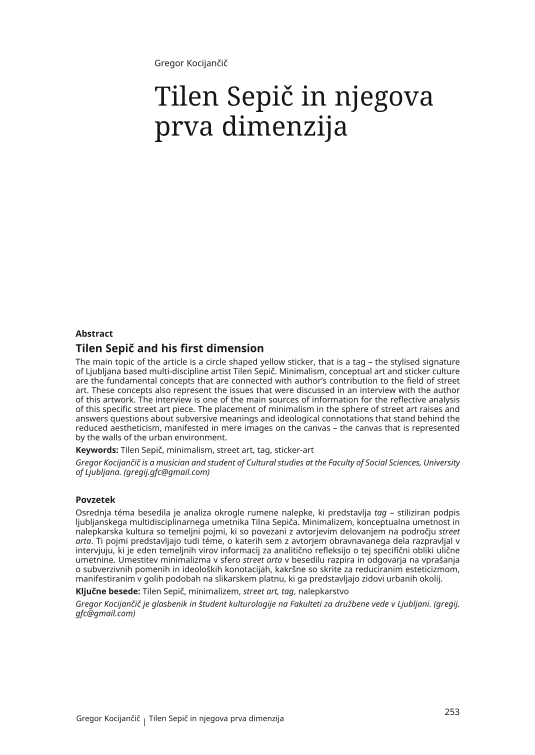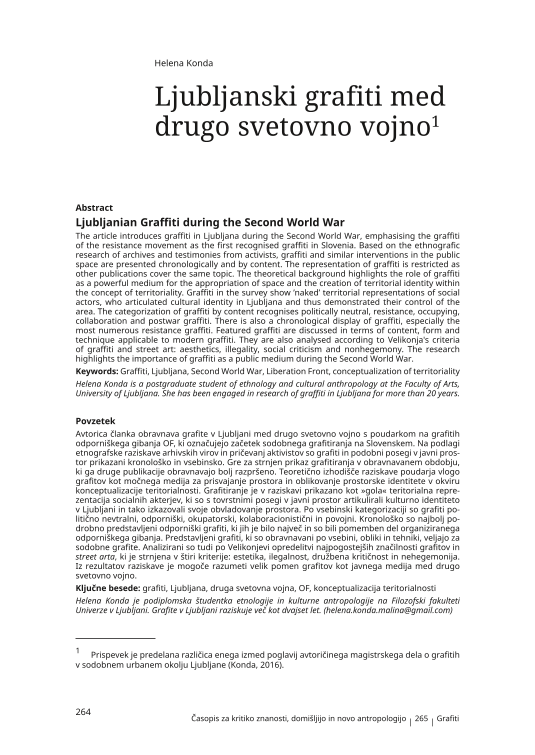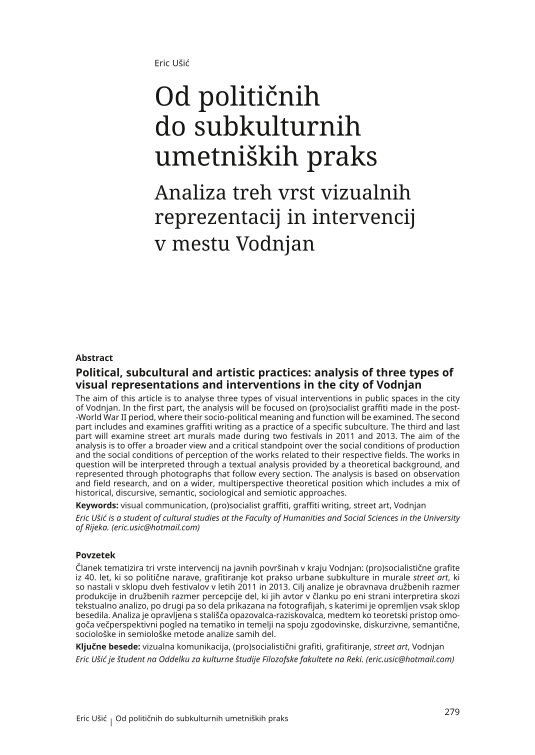Razvoj nevroznanosti in odkritja o tem, kako čutno-zaznavni aparat in možgani sprejemajo ter preoblikujejo informacije, je v zadnjih desetletjih vplival na širjenje novih teorij o kogniciji, subjektivnosti, zavesti in evoluciji. Na področju teorije umetnosti in estetike se uveljavlja nevrokognitivni pristop razumevanja umetnosti, ki so ga omogočila nevrološka proučevanja možganov s sodobnimi medicinskimi tehnologijami, kot so na primer funkcionalna magnetna resonanca, pozitronska emisijska tomografija (PET), računalniška tomografija ali sledenje očesnim gibom (eye-tracking). Nevroestetika je interdisciplinarna znanost, ki razlaga estetsko doživljanje in umetniško ustvarjanje s pomočjo nevroznanstvenih tehnologij in empiričnih metod raziskovanja možganov.
This article provides a critical overview of some findings from neuroaesthetic research. It tries to conceptually divide attributes of phenomenological categories such as aesthetic experience and experience of beauty, and in this way show methodological issues with an unreflected or phenomenologically naïve use. The last chapter expresses doubt concerning the possibility of explaining art through the prism of the information processing paradigm of cognitive science (as it is tried, for example, by Pinker). It shows that the gist of artistic creation (as a cognitive activity) lies precisely in the blind spot of this kind of model of cognition.
Art as a form of symbolic cognition is present only in man. With what purpose? It may fortify social cohesion, it may be a sign of artists’ talent and successful genes, or it may be just a ’sweet’ epiphenomenon of evolution. Recent developments in neuroscience have enabled a deeper dialogue between science and art. From time immemorial artists have tried, consciously or unconsciously, to uncover mechanisms with which to influence the receiver of their art. Neuroscientists search for the structures of the brain that are active during the process of creating or during the process of feeling the object of art and whether universal laws or principles of aesthetics may be defined. Research has discovered that no unique or single brain ’centre for art’ or ’centre for aesthetics’ exists; rather, creating or enjoying art activates broad interconnected regions. These range from ancient ones, present also in reptiles and early mammals (cerebellum) to those, most recent in evolutionary terms, that define humanity itself (prefrontal cortex). In all areas there is a constant interplay between the ’bottom to top’ and ’top to bottom’ mechanisms, as the basic sensory processes are sculpted through high and complex mechanisms of expectations, memories, experiences and emotions.
The use of neurological techniques in neuroaesthetic research on issues related to the brain and perception raises a number of questions about the meaning and methodological advantages of the interdisciplinary connecting of the arts, humanities and sciences. Applying a neurocognitive approach to understanding consciousness, feelings and aesthetic experience – which until recently remained largely in the domain of the speculative – is, despite high expectations, often subjected to critical codes of biological reductionism and materialism. In confronting similar issues, neuroart tests and explores the creative potential of neurological visualisations and theories of perception, awareness, and the brain, which constitute the material basis of consciousness. The methodological and conceptual value of creatively integrating art and neuroscience is reflected in those neuroart practices that strive to overcome the technological, illustrative and aesthetic aspects of an artwork toward cognitive research and the experience of consciousness.
Slavoj Žižek illuminates traditional philosophical questions on subjectivity and consciousness in the light of new discoveries in neuroscience, cognitivism and the philosophy of the mind. He draws attention to the problems of preserving dualistic thinking in materialistic or idealistic approaches in theories of consciousness and the Subject (anti-subjectivistic positions, deconstructive de-centering, affirmation of subjectivity in transcendental philosophy, cognitivism or Freudian–Lacanian subject of the unconscious). The relationship between psychoanalysis and neuroscience today manifests itself either in the awareness of the limits imposed by positive science (cognitivism) regarding the question of subjectification or symbolic integration of bioneurological objectivity of symptoms, or in the search for similarities between neuroscience and psychoanalysis, which would give the latter its scientific legitimacy. Explanations of the emergence of consciousness (from Dennett to Damasio), tend to be “stuck” in auto-referentiality or self-triggering mechanisms, which are constitutive for consciousness.
Sowon Park’s text, translated into Slovene, offers a concise introduction to the field of cognitive literary criticism, how it emerged, how it is defined and how it interrelates with existing criticism. Placing the development of cognitive literary criticism in a historical context, Park identfies a key issue that runs through interdisciplinary research across the divide between the ‘two cultures’ and across time. On the one hand, attempts to integrate scientific and literary knowledge are fraught with scientific reductions of the literary; on the other, attempts to preserve literary knowledge as a different-but-equal field of inquiry risks the complete exclusion from the hegemonic scientific discourse and a further marginalisation. What constructive possibilities there are in the future in the face of such a dilemma are presented and reviewed.
Temenuga Trifonova's article, translated into Slovene, offers a critique of neuroaesthetics and neurocinematics. Advocates of neurocinematics believe the turn to neuroscience will help film theory go beyond ideological, linguistic and psychoanalytic models, i.e. subject-positioning theories (SLAB theory: Saussure, Lacan, Althusser, Barthes), which draw a pessimistic picture of the subject as ’split’ and ’trapped’ both internally (by unconscious forces) and externally (by various ideological discourses, including the film apparatus itself). The author argues that by positing a looping effect between the brain and the screen, neurocinematics shows itself to be an extension of apparatus theory, although one rooted in neuroscience rather than in SLAB theory.
Izuma letala, telefona, električne luči in radia ni nihče naročil. Zgolj samoiniciativa petih posameznikov je spodbudila naštete inovacije, ki so svet predrugačile in zmanjšale. In v tem leži nepričakovana učinkovitost sicer nevidne, toda vsesplošno nalezljive oblikovalsko-znanstvene revolucije. Politika je inherentno zgolj dodatek, ki sledi omenjeni revoluciji. Kljub temu zgodovinsko dokazljivemu dejstvu pa svetovna javnost rešitve za svetovne probleme še naprej išče izključno pri politikih in njihovih ideologijah.
R. Buckminster Fuller
V knjigi The End of Science (1996) John Horgan primarno nalogo čiste znanosti prepozna v iskanju odgovora na vprašanje, zakaj smo tu. Izhajajoč iz dane premise izpelje, da bo znanost z odgovorom na vprašanje hkrati dosegla tudi svoj konec. Povedano drugače, ko (oziroma če) bo področje znanosti doseglo svoj cilj, se bo po Horganovem mnenju soočilo s svojo končnostjo.
If Clive Dilnot was right in saying that design practice is not oriented towards gaining knowledge, but is instead an immanent human activity, focused on the anticipation of needs, which are in turn addressed through the process of translation, than design activity can be construed as, first and foremost, a pursuit of meaning. The idea of will is thus pivotal in design and is immediately expressed through action (that is to say, a product or service). However, any such claim automatically highlights – as implied by the title – the opposite side of the dilemma. Namely: by placing design on the side of meaning, are we not, in fact, saying that design does not think? Or, conversely: since it does not abolish meaning, is it safe to presume that design thinks?
The article explores how the modern movement of do-it-yourself biology, DIYbio or biohackers, which some experts compare to the early garage personal computing and hacker movement in the 80s of the 20th century, could, by combining a broad design approach and traditional hacker ethic, contribute to a more responsible (re)design of organisms for human purposes within the framework of modern biotechnology and synthetic biology. The first part examines how the rapid development of new information and biotechnology tools has led to the emergence of the modern DIYbio movement and the rise of biohackes, and how the new tools of synthetic biology, such as CRISPR, point to even more radical and to the amateur community accessible possibilities for shaping the living world, including humans, which also opens questions regarding safety and responsible use. The second part highlights the importance of a broad design approach entering the sphere of biotechnology and synthetic biology and its intertwining with biohacker values and art, which could be important for ensuring better safety and responsibility in the use of new biotechnological capabilities. It also suggests the possibility of the DIYbio movement influencing the biotechnology business and public research and academic sphere by encouraging a biohacker design approach among the young and amateur biologists and biotechnologists. In the conclusion it emphasizes the importance of interdisciplinary cooperation for shaping a creative and societally broadly desirable bio-designer future.
In today’s world the boundaries between disciplines seem to be becoming increasingly blurred. Tools, once used only by professionals, are nowadays accessible to all, irrespective of their initial experience and knowledge. The question arises, what is the difference between science and design, where are their junctions and where are the conflicts between them? This text attempts to compare science and visual communication design through the analysis of process, methods and examples of design practice, where the areas met, intersected, or developed in parallel. The design profession, as a discipline at the crossroads of science, art and technology, has had, long before any official formal establishment, representatives, who were involved in changing things with visual communication tools. Historical examples as well as contemporary trends in this field enable us to conclude that science and visual communication design are not only related, but they can also mutually influence each other. Therefore the future offers great potential in the interdisciplinary collaboration between the two areas.
The way people communicate has utterly changed during the last two centuries. The invention of photography and film at the end of 19th century caused the first wave of examination about the meaning of pictures and the pictorial. The invention of video and television for broadcasting images over distance and the subsequent digital revolution in the 20th century caused an exponential increase of pictorial information. In line with Moore’s law, which describes a doubling every year in the number of components per integrated circuit, the amount of data in digital format is also increasing. The year 2015 was a watershed in the expansion of data in digital format since it crossed the zettabyte range (ZB = 1021) and by the year 2020 digital data will amount to over 20ZB. Only a few thousands of this huge amount correspond to textural data, the rest corresponds mostly to pictorial data. Due to this reality, a renewed effort to understand and reflect on the meaning of pictorial information is urgently required. A new methodological approach, that will reaffirm the concept of pictorial language, is needed. However, pictorial language is not only a pressing research topic but should be integrated also into the entire educational process to make it an equal and parallel method of instruction.
Among science and design professionals, claims that design and science are merely two different types of intellectual study and production rather than being distinct in kind are largely considered as opposing the conventional view, i.e. that sharp distinctions between design and science make it impossible to equate the two. Nevertheless, in their paper “The Simone-Kroes model of technical artifacts and the distinction between science and design”, Robert Farrell and Cliff Hooker introduce the notion that the separation of science and design is not radical. Per Galle and Peter Kroes pick up the gauntlet, attempting to refute the controversial claim in their paper “Science and design: Identical twins?”, instead aiming to provide an in-depth conceptual clarification of the science–design relationship. Based on scientific theories, this article examines the relevant arguments about the (dis)similitude between science and design.
Konec leta 2015 je v Zagrebu nastala zanimiva pobuda za preimenovanje Željezničkog mosta, poznanega tudi kot Zeleni most, v Hendrixov most. To je najstarejši zagrebški most, katerega zgodovina seže v leto 1862, ki pa je od takrat doživel številne spremembe. Če bo državljanska pobuda dosegla svoj cilj, bo doživel še eno spremembo in ga bodo uradno preimenovali. Zakaj? Zadeva postane bolj jasna, ko se dotaknemo ključnega elementa te zgodbe, ki je obenem tudi razlog, zaradi katerega je pobuda za preimenovanje mostu tudi nastala. V središču te zgodbe je grafit. Grafit Hendrix je na mostu stal desetletja, izpisali so ga vedno znova, kadar so pristojne službe obnovile most in ga izbrisale. Enako se je zgodilo tudi konec leta 2015: ob obnovi mostu so grafit izbrisali, toda takoj se je znova »pojavil« na istem mestu. Potem ko so objavili, da ga bodo spet izbrisali, je nastala Facebook iniciativa z imenom Preimenujmo Željeznički most v Hendrixov most. Pobudi se je v zelo kratkem času pridružilo kakih pet tisoč ljudi, nekoliko pozneje so jo podprle tudi Hrvaške železnice Infrastruktura, institucija, ki je pristojna za most. Prav ta je objavila zanimivo sporočilo za javnost: »Zahvaljujoč grafitu s priimkom slavnega rock glasbenika Hendrixa je ta most dobil zagotovo kultni status in postal eden od simbolov urbane pop kulture mesta Zagreb in del kolektivne zavesti Zagrebčanov.« (HŽ Infrastruktura, 2015)
The article deals with the political-critical potentiality of graffiti and street art, which, despite institutionalisation and incorporation, stubbornly maintains steady torque. To understand the persistence of a multitude of forms of visual production, which deterritorialise marketing, cultural and historical aesthetisation of the modern urban milieu, the article will try to analyse graffiti practice through its own singular logic of deterritorialisation of public space through which it creates spaces of the commons. Epistemologically speaking, it is no longer just a question of the semantic practice of graffiti but the materialistic question of what graffiti is doing. The article consequently discusses the theoretical rotation from ‘signifying’ to a materialistic theory in the field of graffiti scholarship.
Graffiti and street art as mobilising practice: Case study of anti-capitalist block in uprisings of 2012–2013 in Slovenia
(
Mobilisation practices of uprisings and direct actions have become a significant factor in studying demonstrations and social movements in the past few years. However, the process of studying these mobilisation practices is limited mostly to the influence of information technology and social networks as the free and unlimited practices, which significantly form uprisings and protests of the new autonomous movements around the world. In this article, I considered the analysis of graffiti and street art being those mobilisation practices whose mobilisation potential and meaning remain poorly investigated. The role of graffiti as a mobilisation tool was explored twofold: first, through the analysis of the mobilisation graffiti and street art of the Anti-capitalist Block (AKAP) during the Slovenian uprisings that took place in the winter of 2012–13 and, secondly, through the reconsideration of the theory of hegemony. My purpose was to place such mobilisation tool within the context of other mobilisation practices and in the field of non-hegemonism, alongside the information technology. The article is a part of a broader research of the mobilisation practices of the Anti-capitalist Block during the Slovenian uprisings.
Spray Cans Nowhere in Sight: Digitalization and Cybernetic Incorporation of Graffiti and Street Art
(
Based on virtual ethnography, the article problematises the recontextualisation of graffiti and street art from urbanscape to cyberspace. This shift is understood as a continuation of the transposition of graffiti and street art between and within different fields. At the outset, the process is theoretically positioned in contexts of the dematerialisation of art and the consolidation of the new media art. The process is subsequently analysed through three complementary phases: the mechanical enhancement of graffiti, the cybernetic modification of graffiti, and the aesthetic incorporation of graffiti into cyberspace. The research grasps how different aspects and practical examples of graffiti and street art are correlated to robotics, technology, informatics, and the Internet. This represents a springboard for discussing their transformation, canonisation, commodification, and domestication. The text also highlights different grass-root reactions to the above-mentioned processes. In conclusion, some subversive practices of the graffiti and street art subculture that revealed the universal vampirism of the contemporary art world and the capitalistic colonisation of any kind of creativity (including the one directly present on the streets and on the internet) are taken into account.
»Cool hunting« is a widely used practice within the advertisement industry, often used in order to achieve commercial success. The following article aims to present the use of sub-cultural symbols and values within the realm of advertisement, by highlighting various examples and social events, which has led to an increase of graffiti being utilised in marketing and communication campaigns. Companies not only exploit the aesthetics associated with graffiti, but also its role in representing an alternative subculture that is based on a value system celebrating activism, freedom, protest and fun. By connecting these alternative associations to their own image, corporate entities are exploiting various youth cultures as way to increase profit and commercial success. Through the process of hijacking this particular visual subculture, graffiti and street art lose their main purpose and identity–rebellion–and can be only seen as a form of outdoor advertising.
The article is based on the analysis of the urban and visual culture of the city Rijeka with reference to murals that are the products of the project ’Refaj se’ that were financed by the members of Rijeka’s encyclopedia Fluminensia association. The forms of visual culture are made with a view to awake and to connect the citizens of Rijeka with the important historical, cultural and other aspects of the city itself. The main premise in this paper is the culture of memory and the way the murals represent the agents of memory of the city’s past and present, or the linkage of the history, memory and identity. Also, the urban space, in this case the city of Rijeka, is of great importance as a productive field in developing such visual interventions and new ways of communication. The author analyses the theme as a researcher-observer. Starting from the theoretical approach of visual culture and its influence on the urban space, I will continue onto decoding the symbolism of Rijeka’s murals. Photographic recording, critical interpretation of the data and an interview with the author of murals, Edi Gustin ´The Mask´, are the tools used for decoding the visual components of the artworks being studied.
The essay specifically explores the communication role of graffiti. The main question is: what is one writer telling others with his graffiti? The research was conducted in the city of Pula, in the period from March to April 2015, by observing and interviewing two of Pula`s writers. Research results show that a writer, through his graffiti, primarly sends a message of his existence, and also a message about his way and style of writing. The way and style of writing are exactly the things that will create the reputation of a writer, since they are indicators of experience and quality of work and consequently of hierarchical position within the subculture. By recognising the value of someone else`s graffiti, the writer who observes will understand in which way he should treat it. Factors which contribute to a higher hierarchical position are recognition, frequency of leaving marks in urban areas and location selection. The last factor, location, is very important since it shows to whom the writer is speaking (local or outside writers), but it also shows the writer`s innovation or risk exposure, which will contribute to the graffiti`s value and respect from other writers.
The main topic of the article is a circle shaped yellow sticker, that is a tag – the stylised signature of Ljubljana based multi-discipline artist Tilen Sepič. Minimalism, conceptual art and sticker culture are the fundamental concepts that are connected with author’s contribution to the field of street art. These concepts also represent the issues that were discussed in an interview with the author of this artwork. The interview is one of the main sources of information for the reflective analysis of this specific street art piece. The placement of minimalism in the sphere of street art raises and answers questions about subversive meanings and ideological connotations that stand behind the reduced aestheticism, manifested in mere images on the canvas – the canvas that is represented by the walls of the urban environment.
The article introduces graffiti in Ljubljana during the Second World War, emphasising the graffiti of the resistance movement as the first recognised graffiti in Slovenia. Based on the ethnografic research of archives and testimonies from activists, graffiti and similar interventions in the public space are presented chronologically and by content. The representation of graffiti is restricted as other publications cover the same topic. The theoretical background highlights the role of graffiti as a powerful medium for the appropriation of space and the creation of territorial identity within the concept of territoriality. Graffiti in the survey show ’naked’ territorial representations of social actors, who articulated cultural identity in Ljubljana and thus demonstrated their control of the area. The categorization of graffiti by content recognises politically neutral, resistance, occupying, collaboration and postwar graffiti. There is also a chronological display of graffiti, especially the most numerous resistance graffiti. Featured graffiti are discussed in terms of content, form and technique applicable to modern graffiti. They are also analysed according to Velikonja's criteria of graffiti and street art: aesthetics, illegality, social criticism and nonhegemony. The research highlights the importance of graffiti as a public medium during the Second World War.
The aim of this article is to analyse three types of visual interventions in public spaces in the city of Vodnjan. In the first part, the analysis will be focused on (pro)socialist graffiti made in the post-World War II period, where their socio-political meaning and function will be examined. The second part includes and examines graffiti writing as a practice of a specific subculture. The third and last part will examine street art murals made during two festivals in 2011 and 2013. The aim of the analysis is to offer a broader view and a critical standpoint over the social conditions of production and the social conditions of perception of the works related to their respective fields. The works in question will be interpreted through a textual analysis provided by a theoretical background, and represented through photographs that follow every section. The analysis is based on observation and field research, and on a wider, multiperspective theoretical position which includes a mix of historical, discursive, semantic, sociological and semiotic approaches.




